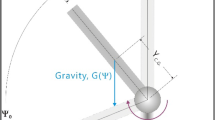Abstract
A previously developed estimation technique, of the minimum energy required for complete fin deployment under an operational requirement of gust speed, was modified to consider time consumed for fin unfolding as an additional requirement, which might lead to an increase of the required energy. Some modifications were made such as non-zero kinetic energy of unfolding fin when completely deployed and its monotonically increasing angular speed during unfolding motion having a profile of square-root function which helped to properly evaluate elapsed time for fin unfolding and to combine the additional time constraint with the fin folding motion equation including external moments of aerodynamics, gravitation, and friction, while, in the previous study, zero energy and bell-shaped speed profile had been used. Demonstrations of this estimation technique considering the time constraint additionally to the gust speed requirement were carried out with the same unfolding fin system and torque profiles used in the previous study and showed that unfolding systems equipped with energy estimated by this technique met all the given gust requirement and time constraint, irrespective of their torque profile, in terms of elapsed time for fin unfolding and allowable wind speed denoting the maximum speed of gust against which in every direction fin could deploy.
















Similar content being viewed by others
Abbreviations
- A :
-
Moment due to aerodynamic force acting on fin (N·m)
- A ref :
-
Reference area for aerodynamic folding moment/damping coefficient (m2)
- α :
-
Angle of attack (deg.)
- β :
-
Angle of sideslip (deg.)
- C :
-
Static aerodynamic folding moment coefficient
- C \(\psi\) :
-
Aerodynamic damping coefficient
- F :
-
Moment due to friction force around hinge (N·m)
- G :
-
Moment due to gravitational force of fin (N·m)
- η :
-
Adjusting factor for angular speed of unfolding fin
- I XX :
-
Moment inertia of rotating part of folded fin about axis of folding hinge (kg m2)
- L ref :
-
Reference length for aerodynamic folding moment/damping coefficient (m)
- M :
-
Mass of rotating part of folded fin (kg)
- q ∞ :
-
Free stream dynamic pressure (Pa)
- t req :
-
Time constraint for fin deployment (s)
- V ∞ :
-
Free stream velocity (m/s)
- Y C.G. :
-
Span length between axis of folding hinge and center of mass of rotating part of fin (m)
- ψ :
-
Folding angle or deploying angle (deg.)
- Z :
-
Torque generated by unfolding device (N·m)
- Ω :
-
Ideal angular-speed of deployment (rad/s)
- LE:
-
Least energy required when considering gust speed requirement only
- TC:
-
Least energy required when considering both gust speed requirement and time constraint
References
Kayser LD, Brown TG (1992) “Fin Motion after Projectile Exit from Gun Tube”, AIAA-92–4491-CP
McGrath BE (2004) “Subsonic Aerodynamic Fin-Folding Moments for the Tactical Tomahawk Missile Configuration”, AIAA Paper 2004–5193
Jung SY, Yoon SJ (2010) Aerodynamic modeling of folded fin for unfolding motion simulation. J Spacecraft Rock 47(3):413–418
Lee Y (2019) A Study on Aerodynamic Loads of a Deploying Wing Launched from a Mobile Platform. Journal of the KIMST 22(3):353–359
Jung SY, Lee Y (2020) Estimation technique of minimum energy required for complete deployment of folded fin under gust requirement. Int J Aeronaut Space Sci 21(1):163–171
Jung SY, Yoon SJ (2008) A study of aerodynamic modelling for fin unfolding motion analysis. J Korean Soc Aeronaut Space Sci 36(5):420–427
Author information
Authors and Affiliations
Corresponding author
Additional information
Publisher's Note
Springer Nature remains neutral with regard to jurisdictional claims in published maps and institutional affiliations.
Rights and permissions
About this article
Cite this article
Jung, S.Y. Estimation Technique of Minimum Energy Required for Complete Deployment of Folded Fin Under Gust Requirement (II): Considering Time Constraint. Int. J. Aeronaut. Space Sci. 22, 813–823 (2021). https://doi.org/10.1007/s42405-021-00350-6
Received:
Revised:
Accepted:
Published:
Issue Date:
DOI: https://doi.org/10.1007/s42405-021-00350-6




